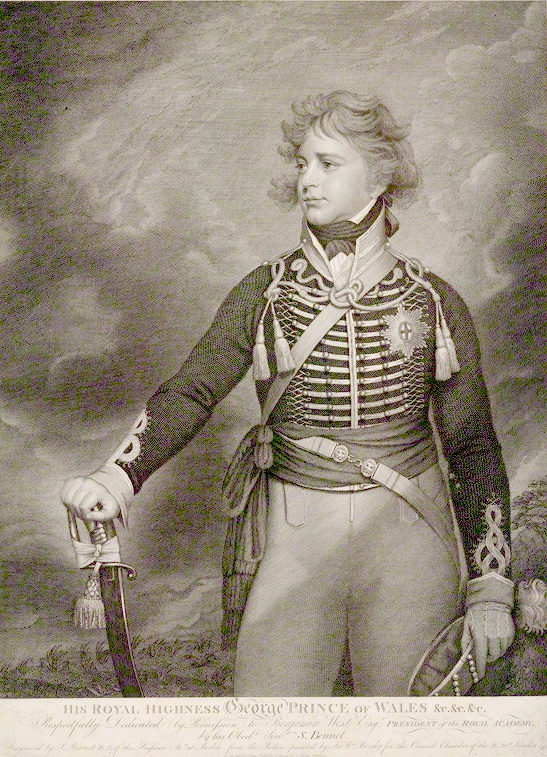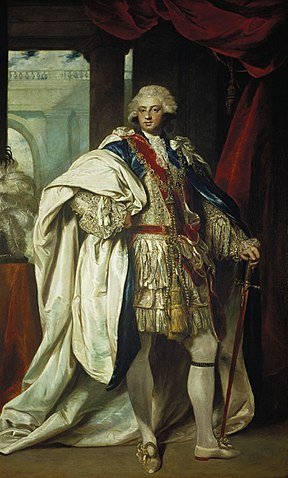The Prince of Wales
 |
| George Prince of Wales |
Prince
George was an intelligent man with an appreciation of the arts. His downfall
was his extreme selfishness. He supported the opposition to his father and his
debts were prodigious. George had a number of affairs before marrying Mrs
Fitzherbert in 1785, in breach of the Royal Marriages Act. Mrs Fitzherbert was
also a Roman Catholic, which debarred George from the throne. Prince George
simply denied the marriage had taken place. Many of Prince George’s vast debts
were paid by his frugal father.
George decided
that marriage would steady his son and Prince George married his cousin
Princess Caroline of Brunswick on 8th April 1795. The couple took
against each other immediately. The only child of the marriage, Charlotte, was
born on the 7th January 1796. The couple separated shortly
afterwards. The king treated the Princess of Wales kindly and ensured she had
access to her daughter. George and Charlotte also made sure that they had close
contact with their only grandchild.
Madness and Death
George’s
first serious bout of madness occurred in 1788. He was unwell in the August and
then in mid-October was struck down. He alternated between consciousness and
fits of delirium. His madness enveloped him entirely by the 5th
November. He was restrained in a strait-jacket or in sheets.
‘I am nervous. I am not ill,
but I am nervous: if you would know what is the matter with me, I am nervous.’[i]
The king was
transferred to Kew and on 5th December the frightening Dr Willis
arrived. Willis believed in terrifying patients into submission. George was
subjected to his frightening regime, being tied into a straitjacket at nights
and restrained in a chair and gagged during the day.
The
politicians meanwhile were fighting over control of the kingdom. The Opposition
were calling for a Regency, while the government were desperate to keep the
Prince of Wales from installing his friends in power. But by February the
king’s health was improving. On the 17th George met with his Lord
Chancellor. The third and final reading of the Regency bill was due in the
Commons on the 19th, that day the Lord Chancellor announced from the
Woolsack that it would be inappropriate to proceed with the reading. George met
with his Prime Minister on 24th February. The country rejoiced at
the king’s recovery.
On his
recovery George was unhappy to discover the Prince of Wales’ involvement in the
crisis. During the king’s illness it was discovered that the king was devoting
£14,000[ii]
a year, of his £80,000[iii]
per annum income, to charity, well over the tithe recommended by the church.
Bust of Dr Willis
In February
1801 the madness returned and George prayed that he might die rather than lose
his sanity again. Again George was placed in the care of Dr Willis and his
cohorts. By 14th March George was well enough to receive the seals
of office from Pitt as he resigned. Willis and his men were dismissed on 17th
April, but on the 18th they detained him at Kew. On 19th
May George refused to sign anymore documents unless he was released and gained
his freedom. He had already told the Reverend Thomas Willis[iv],
who he had quite liked,
‘Sir, I will never forgive
you whilst I live’[v].
In
January1804 George again suffered another bout of madness and the Prime
Minister, Lord Addington called in the Willis family. But George had made his
sons promise him that he would never again be placed in their care. The Duke of
Kent and the Duke of Cumberland physically interposed themselves between the
Willis family and their father. Even so the replacement doctor restrained the
king. George was considered well enough to allow a change of prime ministers,
much to the surprise of the Prince of Wales, again angling for a Regency;
‘So extra-ordinary a
circumstance as a King of England whilst exercising his Regal powers being kept
under any personal restraint.’[vi]

Frederick Duke of York
On 20th July
George was moved to Windsor. This latest occurrence of George’s illness caused
an unfortunate permanent rift between himself and Queen Charlotte. They were
never to live together again.
George
developed a cataract in his right eye in 1804 and the following year another
started in his left eye. He could no longer see when the ink in his pen had run
out and the king was finally persuaded to take a secretary. George shared Sir
Herbert Taylor, the Duke of York’s secretary with his son. George’s Golden
Jubilee was celebrated on 25th October 1810. The king was immensely
popular with his subjects, in contrast to the unpopularity of the Prince of
Wales.
In 1810
George was badly affected by the final illness of his youngest daughter
Princess Amelia. She was dying of tuberculosis. By the time of his jubilee it
was obvious that he was unwell again and on 19th December the Prince
of Wales was informed by Spencer Perceval of his determination to introduce
legislation to establish a Regency. On 5th February 1811 the Regency
was officially installed.
George in his last years
George spent
the rest of his life in a suite of rooms at Windsor Castle, under the care of
Queen Charlotte and the Archbishop of Canterbury. After Charlotte’s death her
place was taken by the Duke of York. It cannot have helped the king’s sanity
when the Willis family took care of the king again. Unfortunately for him and
his family George’s strong constitution kept him alive until 29th
January 1820, having outlived his wife, numerous children and his granddaughter
Princess Charlotte.
There was a
national outpouring of grief, exceeding that even of the death of Princess
Charlotte. The funeral took place on Wednesday 16th February 1620.
All the shops in London were shut and the churches were full; non-conformist
churches and synagogues held services too. George’s subjects appreciated their
monarch’s unpretentious virtues and simple pieties. The Times commented
‘Thousands of affectionate
subjects, who had thronged to the last obsequies of their King, not from the
idle curiosity of seeing a grand exhibition, but to shed a last tear over the
grave of a father and a friend.’[vii]
Bibliography
Fanny
Burney – Claire Harman, Flamingo 2001
George
III – A Personal History – Christopher Hibbert, Viking 1998
The
Reign of George III – J Steven Watson – Oxford University Press 1988
The
Age of Reform – Sir Llewellyn Woodward, Oxford University Press 1997
George
III – Christopher Wright, British Library 2004
En.wikipedia.org
[i]
Fanny Burney - Harman
[ii]
£1,150,000.00 using the retail
price index or £14,500,000.00
using average earnings in 2010 www.measuringworth.com
[iii]
£6,570,000.00 using the retail
price index or £83,100,000.00
using average earnings in 2010 www.measuringworth.com
[iv] A
son of Dr Willis
[v]
George III - Wright
[vi]
Ibid
[vii]Ibid


No comments:
Post a Comment
Note: only a member of this blog may post a comment.